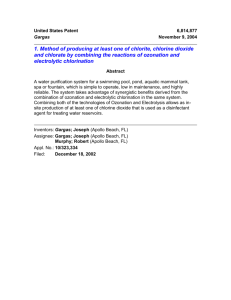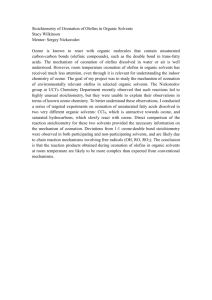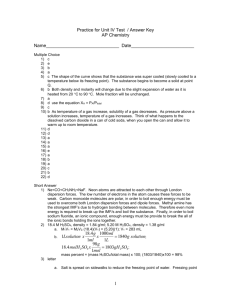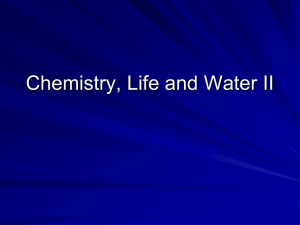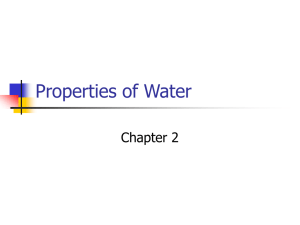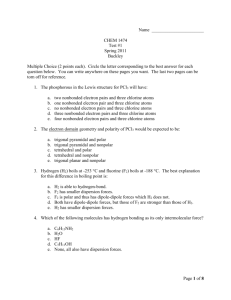Key
advertisement
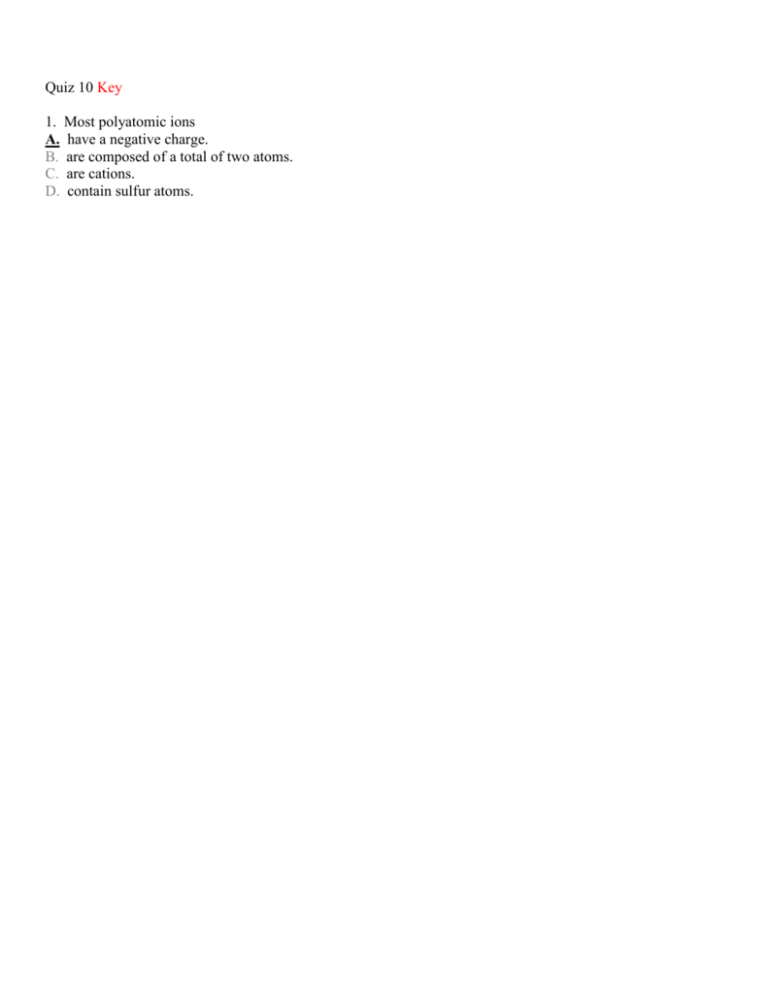
Quiz 10 Key 1. Most polyatomic ions A. have a negative charge. B. are composed of a total of two atoms. C. are cations. D. contain sulfur atoms. Only ammonium is positive. 2. A 0.25 M aqueous solution of potassium chloride, KCl, is tested for conductivity using the type of apparatus shown. What do you predict will happen? A. B. C. D. The bulb will not light up. KCl is a nonelectrolyte. The bulb will not light up. KCl is in the molecular form when dissolved in water. The light bulb will shine dimly. KCl is only partially ionized in aqueous solution. The light bulb will shine brightly. KCl is highly ionized in aqueous solution. Remember that ions carry electric charge. 3. When the ________molecules of ethanol, C2H5OH, are added to water, the ethanol molecules ________. A. nonpolar; are attracted to the nonpolar water molecules. B. polar; form hydrogen bonds with the polar water molecules. C. polar; form covalent bonds with the polar water molecules. D. nonpolar; are not attracted to the polar water molecules. Remember that O and H have different electronegativities. 4. Which compound should be the most soluble in water? A. B. C. D. Remember that "like dissolves like". 5. Which compound is insoluble in water? A. sodium carbonate B. potassium nitrate C. ammonium chloride D. calcium carbonate Remember that 1A ions and ammonium are always soluble. 6. The EPA regulates the presence of nitrates and nitrites in water because A. they produce nitrogen in the blood, causing a condition similar to the bends deep sea divers can suffer from. B. as with ammonium nitrate fertilizers, they may cause small explosions in blood vessels causing them to rupture. C. they interact with naturally occurring ozone in the body and remove it from the circulatory system. D. they interact with the blood and limit its ability to transport oxygen. Think about this a bit more. 7. What are the major disadvantages of using ozone instead of chlorine to disinfect water? A. Ozonation is more expensive than chlorination and ozone leaves an odor in the water. B. Ozonation causes trihalomethane formation and leaves an odor in the treated water. C. Ozonation causes trihalomethane formation and is more expensive than chlorination. D. Ozone decomposes quickly and does not provide long-term protection against possible contamination as the water is piped through a municipal distribution system. Remember that ozone does not persist in the water after its purification step is complete. 8. Which form of water disinfection continues to provide antibacterial protection after the water leaves the purification plant? A. chlorination B. ozonation C. UV radiation D. filtration Only one of these stays in the water after it leaves the plant. 9. Potable water is water that A. contains residual chlorine. B. is safe to drink and to cook with. C. is contaminated with lead. D. contains too much residual ozone to be drinkable. Water that you should not drink is "non-potable". 10. We cannot effectively clean nonpolar substances from our hands or clothing with water alone; we must add soap or detergent. The structure of a typical soap molecule is shown below. Which region of this molecule would dissolve in a nonpolar substance such as grease? A. B. C. D. Region 1 Region 2 Region 3 Region 4 Remember that long chain hydrocarbons are a component of oil and gasoline. 11. Which ions, if present in drinking water, would pose a significant health risk? I. Pb2+ II. Hg2+ III. Cd2+ IV. Ca2+ A. B. C. D. I, II, and III only II, III, and IV only I, III, and IV only I, II, III, and IV One of these is essential for bone health while the rest are toxic. 12. Which of these is not a trihalomethane? A. CHCl3 B. CH3Cl C. CHF3 D. CHBr2Cl Remember the "trihalo-" means three halogens. 13. Reverse osmosis is illustrated in this diagram. What is this process used for? A. B. C. D. to purify water by ion exchange to remove dissolved salts from sea water for the ozonation of water supplies to add fluorine to municipal water supplies Only one of these would result in concentrated brine (or salt water). 14. Which compound has an incorrect formula? A. MgPO4 B. (NH4)2S C. Mg(HSO3)2 D. NaClO4 Pull these apart into two ions and see if the charge is balanced correctly. 15. Which compound has a correct formula? A. CaSO3 B. Ca2SO4 C. Mg(CO3)2 D. Na2PO4 Pull these apart into two ions and see which have the proper charges and are balanced.
